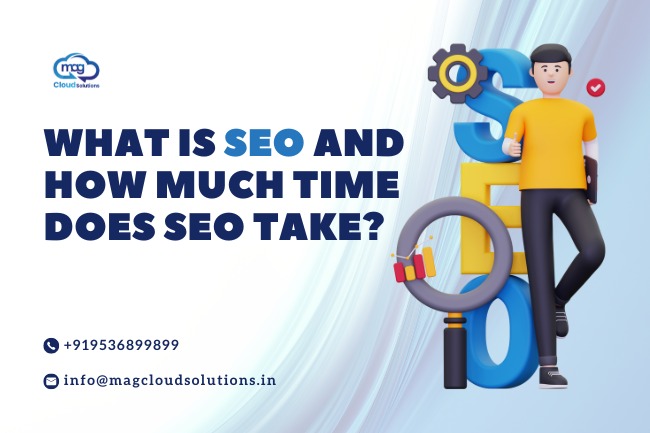Within the field of digital marketing, Search Engine Optimization (SEO) is a fundamental tactic utilized by companies looking to improve their online exposure and presence. Optimizing several components of a website to rank higher in search engine results pages (SERPs) is a complex strategy. However, getting meaningful SEO results takes time and requires a well-thought-out plan in addition to patience and perseverance. We’ll explore the nuances of SEO, its essential elements, and the amount of time required to see results in this in-depth guide.
Understanding SEO
A variety of methods and strategies are included in SEO with the goal of increasing a website’s exposure in natural search results. Improving a website’s relevance and authority in the eyes of search engines like Google, Bing, and Yahoo is the main goal. Search engines mine the web for relevant and reliable results when users enter particular terms or phrases pertaining to a company or subject. By ensuring that a website appears highly for pertinent keywords, SEO helps attract targeted traffic and possible clients.
Core Components of SEO
1 Keyword Research: SEO starts with figuring out what words and phrases people are searching for. To choose which keywords to target, keyword research includes examining search volume, competition, and relevancy.
2 On-Page Optimization: This entails aligning targeted keywords with other website elements, like meta tags, headings, and content, to enhance the site’s relevance to search queries.
3 Content Creation and Marketing: Creating pertinent, high-quality content that speaks to the needs and interests of the target audience is essential for search engine optimization. There are many different types of content, such as blog entries, articles, movies, and infographics.
4 Link Building: Establishing a website’s authority and credibility requires building a strong backlink profile. To tell search engines that a website is reliable, one way to accomplish this is to obtain links from other reliable and pertinent websites.
5 Technical SEO: A website’s crawlability, mobile friendliness, and performance can all be optimized to provide a seamless user experience and increased search engine visibility.
Timeframe for SEO Results
For businesses and marketers, one of the most frequent questions is how long SEO takes to produce results. But it’s crucial to understand that SEO is a long-term commitment rather than a short-term remedy. The timeframe for observing notable SEO results is influenced by a number of factors:
1 Website Age and Authority: Results may be seen more quickly by well-established websites with a track record of high-quality content and backlinks than by less-established or newer websites.
2 Competition: The amount of time it takes to succeed with SEO can vary depending on the degree of competition in a certain sector or specialty. It could take more time and effort in highly competitive markets to outperform rivals.
3 Current State of SEO: Resolving and efficiently optimizing websites with substantial technical issues or those that have undergone prior SEO efforts may take longer.
4 Consistency and Quality of Efforts: Results can be accelerated by regularly putting SEO best practices into effect and by creating excellent content. On the other hand, inconsistent or poor-quality work could impede advancement.
5 Algorithm Updates: Search engine algorithms are constantly evolving, and major updates can impact a website’s rankings. Adapting to algorithm changes and maintaining a proactive approach to SEO is essential for long-term success.
SEO Timeline: What to Expect
While the timeframe for seeing tangible SEO results can vary significantly based on the factors mentioned above, it’s helpful to outline a general timeline to manage expectations:
1. Initial Phase (0-3 Months):
1 Conducting comprehensive website audits and keyword research.
2 Implementing on-page optimization strategies.
3 Addressing technical SEO issues and improving site performance.
4 Creating a content strategy and publishing high-quality content.
2. Mid-Term Phase (3-6 Months):
1 Building a diverse backlink profile through outreach and content promotion.
2 Monitoring and analyzing performance metrics, such as rankings and organic traffic.
3 Adjusting strategies based on insights and emerging trends.
4 Continuously optimizing existing content and identifying new keyword opportunities.
3. Long-Term Phase (6+ Months):
1 Gradually increasing visibility and authority in search results.
2 Establishing a strong online presence and brand recognition.
3 Sustaining growth through ongoing content creation, optimization, and link building efforts.
4 Adapting to algorithm changes and industry shifts to maintain competitiveness.
Frequently Asked Questions (FAQs) About SEO
How does SEO differ from paid advertising?
While paid advertising is paying for ad positions inside search engine results or other online platforms, SEO concentrates on increasing a website’s organic presence in search results rankings. While paid advertising offers instant visibility but necessitates continuous investment, SEO results are acquired gradually through optimization work.
How often should I update my website’s SEO strategy?
SEO is a continuous process that needs to be regularly observed, evaluated, and adjusted. Periodically reviewing and updating your SEO strategy is advised, especially in reaction to changes in the competition, industry trends, and algorithm. You can stay competitive and gradually raise or maintain your search engine rankings by continuously improving your website and content.
What are the most important factors for successful SEO?
Researching keywords, creating high-quality content, generating links, on-page optimization, technological optimization, and user experience are all important components of successful SEO. However, as search engines give preference to websites that offer consumers relevant and useful material, user-centricity is fundamental to successful SEO. You may improve your website’s exposure and search engine rankings by giving your target audience’s demands and interests first priority and providing an amazing user experience.
How do algorithm updates affect SEO strategies?
Search engine algorithms are always changing to provide users with more relevant and helpful results. Significant algorithm changes, like Google’s core modifications, might affect search ranks and force changes to SEO tactics. It’s critical to keep up with algorithm updates, keep an eye on how they affect the functionality of your website, and modify your SEO strategy as necessary. Through ethical SEO tactics, great user experience, and content of the highest caliber, you may reduce the effects of algorithm changes and gradually preserve or even increase your website’s search engine visibility.
Conclusion
Handling the complexities of SEO requires a solid understanding of its core principles, ongoing commitment, and flexibility in response to shifts in the online landscape. Businesses may optimize organic search traffic, enhance their online presence, and achieve sustained success in the digital marketplace by taking a thorough approach to optimization and providing answers to often asked questions about SEO.






